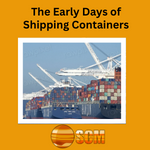Prior to the advent of shipping containers, transportation of goods was an uphill task. Wooden crates and barrels were being used to ship goods, but this method was inefficient and time-consuming. This is because each item had to be individually loaded and unloaded from ships, leading to significant delays and increased costs. This however served as an inspiration as a visionary American trucking entrepreneur named Malcolm McLean saw an opportunity to revolutionize the industry.


McLean realized the need for a consistent method to expedite the transportation of commodities. He began experimenting with the concept of using standardized containers that could be readily carried into and off of ships. When the Ideal X, the world’s first container ship, set sail in 1956, his vision became a reality. Shipping containers soon gained popularity and changed the logistics business..
Standardization and the Birth of Intermodal Transportation
The key to the success of shipping containers was standardization. McLean’s containers were homogeneous in size and shape, allowing for easy movement between modes of transportation. This standardization gave rise to the idea of intermodal transportation, which allowed commodities to be carried from one site to another without the need for continual loading and unloading. Containers could be readily shifted from ships to trains or vehicles, significantly reducing the time and cost of transportation.
The impact of standardization was immense. It allowed for the efficient movement of goods on a scale never seen before. Ports around the world adapted to accommodate container ships, investing in infrastructure to handle the growing demand. Container terminals with specialized equipment were built to facilitate the loading and unloading of containers from ships onto other modes of transportation. The adoption of standardized containers also led to the development of specialized container ships designed to carry large numbers of containers.
Advancements in Container Technology


Advancements in container technology have played a significant role in improving the efficiency and safety of transporting goods. Refrigerated containers, also known as “reefers,” have been instrumental in the transportation of perishable goods. These containers are equipped with temperature control systems, allowing for the transport of goods such as fruits, vegetables, and pharmaceuticals over long distances without compromising their quality.
Insulated containers have also been developed to protect goods from extreme temperatures. These containers are used to transport goods that are sensitive to heat or cold, ensuring that they arrive at their destination in optimal condition. The development of lighter and stronger materials has made containers more efficient, reducing fuel consumption and the environmental impact of shipping.
The Impact of Shipping Containers on Global Trade
The invention of shipping containers has had a transformative effect on global trade. Before the widespread use of containers, loading and unloading goods was a labor-intensive process that often resulted in damage and delays. With the introduction of standardized containers, the entire process became much more efficient. Goods can now be loaded and unloaded quickly and easily, reducing costs and increasing the speed of transportation.
The impact on global trade has been profound. Containers have facilitated the growth of international commerce by providing a reliable and cost-effective means of transporting goods. The time and cost savings associated with containerization have made it easier for businesses to expand their markets and reach customers around the world. The increased efficiency and reliability of shipping containers have also made it possible for businesses to engage in just-in-time manufacturing and inventory management practices, further enhancing productivity and profitability.
Future Developments in Containerization
The shipping container industry continues to evolve, driven by the need for increased efficiency and sustainability. One area of focus is the development of smart containers. These containers are equipped with sensors and tracking technology that provide real-time information about the location, condition, and contents of the container. This level of visibility can help optimize supply chain management, improve security, and reduce the risk of theft or damage to goods.
Smart containers offer numerous benefits for the logistics industry.
With real-time tracking, companies can monitor the progress of their shipments and make informed decisions about routing and delivery. The data collected by smart containers can also be used to identify bottlenecks and inefficiencies in the supply chain, allowing for continuous improvement and optimization.
Another area of development is the use of eco-friendly materials in container construction. As sustainability becomes a priority for many industries, including logistics, there is a growing demand for containers made from recyclable or biodegradable materials. The use of eco-friendly containers can help reduce the environmental impact of shipping and contribute to a more sustainable future.
The development of automated container handling systems is gaining traction.
These systems use advanced robotics and artificial intelligence to automate the process of loading and unloading containers. Automated systems offer several advantages, including increased efficiency, reduced labor costs, and improved safety. They can also help optimize the use of space within container terminals, maximizing throughput and reducing congestion.
Shipping containers have revolutionized the logistics industry, enabling the efficient and reliable transportation of goods around the world. The standardization of containers and the development of intermodal transportation have significantly reduced costs and time, opening up new opportunities for global trade. Advancements in container technology, such as refrigerated and insulated containers, have expanded the range of goods that can be transported, while also improving safety and reducing environmental impact.
Looking ahead, the development of smart containers, eco-friendly materials, and automated handling systems promises further advancements in containerization. These innovations will continue to improve efficiency, increase supply chain visibility, and enhance sustainability in the logistics industry. As global trade continues to expand, shipping containers will remain a vital component of the global economy, facilitating the movement of goods and driving economic growth.
Sources:
- Levinson, M. (2006). The Box: How the Shipping Container Made the World Smaller and the World Economy Bigger. Princeton University Press.
- SeaCube Container Leasing. (2023). Refrigerated Containers. Retrieved from https://www.seacubecontainers.com/equipment/refrigerated-containers
- Smart Containers. (2023). How Smart Containers Are Changing the Shipping Industry. Retrieved from https://www.smartcontainers.ch/how-smart-containers-are-changing-the-shipping-industry/
- Durapak Supplies. (2023). The Advantages of Using Insulated Shipping Containers. Retrieved from https://www.durapak.net/advantages-of-insulated-shipping-containers.htm
- Drewry. (2022). Container Terminal Operators Face New Realities. Retrieved from https://www.drewry.co.uk/news-container-terminal-operators-face-new-realities
Check out our Blog for more lgistics insights, tips and trends


